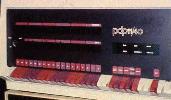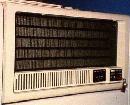
The main part of my collection consists of a room nearly full of various models of DEC PDP-11 Minicomputers. The room is only 12 feet by 14 feet, and both walls are lined with the 6 foot racks containing the computers. There is only a 4 foot aisle between the two rows of racks. The picture above is along the west wall. The PDP-11/24 and some of the Data General computers are housed along the east wall.
The PDP-11 family has probably been the most successful minicomputer ever (though the PDP-8 was also immensely popular). The PDP-11 had a very concise and consistent architecture; almost RISC like. The DEC VAX computer line followed the PDP-11, but it's architecture was much more complicated. The PDP-11 also introduced the DEC UNIBUS® bus design. The UNIBUS allowed peripherals to be addressed within the same addressing scheme as regular memory, and supported direct memory access by peripherals, aribitrated by the CPU. This is not unlike the buses used today inside PC's. (Many VAX models also sported UNIBUS). The design of the Intel 8080 and 8086 microcomputers probably owe much to the PDP-11 design.
We'll start our tour with the initial PDP-11 machines, the PDP-11/20, the PDP-11/45 and the PDP-11/40. The collection actually has two PDP-11/20 computers. One belongs to me, and the other belongs to my friend Hannes Beinert.

My PDP-11/20 was, like many machines, sold to me via the University of Wisconsin surplus program. This particular machine happened to be originally located in the Electrical Engineering Department real-time control lab that was sponsered by Professor Richard Marleau. Inside the panel, just above the CPU, is an RC11 disk drive. The RC11 is a 65K word (128 K byte) fixed head disk drive. After all these years (the system was first purchased around 1970) it still works!
 Hannes' PDP-11/20
Hannes' PDP-11/20Hannes' PDP-11/20 was rescued by Hannes and me after a surprise telephone call from a former girlfriend, who indicated that it was about to be thrown out in the trash. It had a cute little sign pasted on it, which read: "UW SURPLUS WAS HERE - THIS IS JUNK! CALL BUILDING & GROUNDS FOR DISPOSAL." Fortunately, we beat them to the punch! (We still have the sign). Hannes' system is the only one in the collection which has RK03 disk drives, the predecessor to the RK05.

The PDP-11/45 is of approximately the same vintage as the PDP-11/20, but is a much more sophisticated machine. For one thing, it was a micro-coded CPU. It had robust memory management, not seen in microcomputers from Intel until the 80386. It could also support two separate buses: one primarily intended for memory, and the second generally used for peripherals. This is not unlike today's "local bus" PC's. I cut my teeth on Unix on a PDP-11/45 system at the University of Wisconsin in 1976 along with my friends Paul and Hannes (among others).
Unfortunately, my 11/45 CPU has a problem: It's floating point is not
operating correctly.
Fortunately, someone recently contacted me, and has drawings for my floating point
unit (but not my processor) which brings me to...
I recently learned that not all PDP-11/45's are the same CPU. Later 11/45's were made
with KB11-D processors (similar to an PDP-11/55), rather than the original KB11-A, and with
an FP11-C floating point unit instead of the older FP11-B. My
particular PDP-11/45 was field upgraded somewhere along the line and has a KB11-D and FP11-C.
So no WONDER that the floating point diagnostics are confused! See my
wish list, as I still need drawings for my KB11-D processor.
 The PDP-11/40
The PDP-11/40The PDP-11/40 is of slightly later vintage than the PDP-11/20 and PDP-11/45. Unlike the PDP-11/20, it has memory management, and thus can support more than 56K bytes of memory. However, it does not have the robust systems that were employed on the PDP-11/45. In particular, it did not support splitting data and instruction accesses into separate address spaces as was possible on the PDP-11/45. Like the 11/45, though, it is a micro-coded CPU. Although this system, like most in my collection, still runs, it has a little problem doing fixed point multiply correctly, which I have yet to fix.
Next on our PDP-11 tour are the PDP-11/05 family machines, the PDP-11/05 and GT-40. Both used a more modular CPU than their predecessors. One quirk of these machines was that there was only one row of lights, that served for both displaying address and data information, depending on whether or not the "LOAD ADRS" "EXAM" and/or "DEP" switches were depressed.
 The PDP-11/05
The PDP-11/05The GT40 was a graphic system, often used as a graphic terminal for DEC's PDP-10 and PDP-20 mainframe systems. The CPU was a PDP-11/05, but used the green color scheme of DEC's graphic systems rather than the magenta color scheme normally found on PDP-11's. The GT-40's main claim to fame is probably the famous Lunar Lander game, written by Jack Burness, as a consultant to Digital at the time.
 The PDP-11/34
The PDP-11/34This PDP-11/34 was the first PDP-11 in my collection, and the second computer, overall. It was purchased from Midwest Systems, Inc., a used Digital Equipment dealer. (It cost me real money - this was just before I realized the people were more often than not simply discarding such systems as space consuming junk. Gee -- maybe they were right!). The PDP-11/34 featured most of the features of the PDP-11/45, though not the split bus design. It also featured a micro-coded CPU (like the 11/45 and 11/40), including a numeric keypad and seven-segment digital display, which took the place of the previous system of lights and switches. Peripherals for my PDP-11/34 include several RK05 disk drives and a DEC Tape tape drive.
After a few years, microprocessor technology was brought to bear on the PDP-11 architecture. Although there are older microprocessor based PDP-11's, the first machine on our tour is the PDP-11/23. Like most of the microprocessor based machines (except for the PDP-11/24, below), this PDP-11/23 uses a descendent/"knock off" of the UNIBUS called the LSI bus. The disk drive in the PDP-11/23 full picture is an RL01.

The PDP-11/24 uses basically the same CPU as the PDP-11/23, but is a UNIBUS design, rather than an LSI bus design. This PDP-11/24 came from the University of Wisconsin School of Business. It had been housed in historic Bascom Hall, from where we removed it after purchasing it thru the UW surplus program.
 The PDP-11/24
The PDP-11/24In this somewhat cluttered PDP-11/24 system picture, you can see the VT100 terminal and RK07 disk drives that we obtained with the system. Not visible in this picture is the TU10 we obtained at that time. It is stored in a rack along the west wall (it is a completely different vintage than the PDP-11/24, in any event).
Finishing up our PDP-11 tour are two more LSI-11 (microcomputer) based PDP-11's. One is a very special machine to my friend Hannes. It is the H11, a joint effort of Digital Equipment and Heathkit.

Finally, the last PDP-11 on our tour: the MINC-11. The MINC-11 was, in essence, a PDP-11 designed to replace the PDP-12. Like the PDP-12, it has numerous analog and digital I/O options that can be used. Unfortunately, this system is stored, somewhat ignominiously, on its side, for the present.
 The MINC-11
The MINC-11[Back to Jay's Home Page] [Up to the Collection] [Back to the PDP-8 and PDP-12] [On to the DG's]